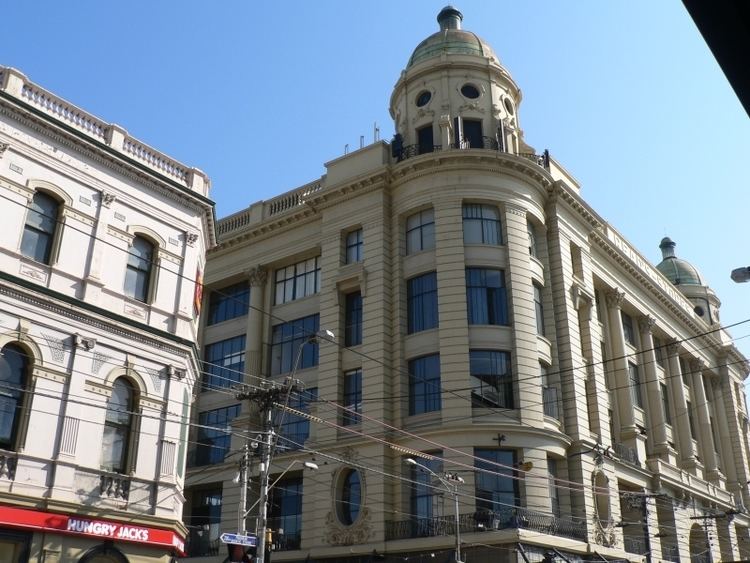Population 11,191 (2011 census) Postcode(s) 3181 State electorate(s) Prahran Postal code 3181 | Established 1837 LGA(s) City of Stonnington Area 210 ha | |
 | ||
Location 5 km (3 mi) from Melbourne Weather 19°C, Wind SE at 6 km/h, 90% Humidity Points of interest Victoria Gardens, Justin Art House Museum, E+Hive art & design gallery | ||
Prahran (/pɛ'ræn/, also known colloquially as "Pran") is an inner suburb of Melbourne, Victoria, Australia, 5 km south-east of Melbourne's Central Business District. Its local government area is the City of Stonnington. At the 2011 Census, Prahran had a population of 11,191.
Contents
- Map of Prahran VIC 3181 Australia
- History
- Demographics
- Non residential architecture
- Residential architecture
- Public space
- Transport
- Notable people
- References
Map of Prahran VIC 3181, Australia
Prahran is a part of Greater Melbourne, with many shops, restaurants and cafes. The area of Prahran, centred along Commercial Road was one of Melbourne's gay villages, but no longer is.
The shopping street Chapel Street is a mix of upscale fashion boutiques and cafes. Greville Street, once the centre of the Melbourne's hippie community, has many cafés, bars, restaurants, bookstores, clothing shops and music shops.
Prahran takes its name from Pur-ra-ran, a compound of two Aboriginal words, meaning "land partially surrounded by water", in 1837 by George Langhorne. The proximity of the Yarra River and a swamp to the southwest (Albert Park Lake is the remnant) explains that description.
History
In 1837 George Langhorne named the area Pur-ra-ran, a compound of two Aboriginal words, meaning "land partially surrounded by water". When he informed the Surveyor-General Robert Hoddle of the name, it was written as "Prahran".
Prahran Post Office opened on 1 April 1853.
Describing Prahran, as it was in the mid 1850s, F.R. Chapman remembered:
Between the 1890s and 1930s Prahran built up a huge shopping centre, which by the 1920s had rivalled the Melbourne Central Business District. Large emporiums (department stores) sprang up along Chapel Street. Prahran also became a major entertainment area. The Lyric theatre (also known as the fleahouse), built on the corner of Victoria Street in 1911, burnt down in the 1940s. The Royal was the second old theatre built. The Empress (also known as the flea palace), another popular theatre on Chapel Street, was destroyed by fire in 1971. The site was operated by the cut-price clothes and homewares chain Waltons for the next decade and was later developed into the Chapel Street Bazaar.
In the 1960s, in an effort to boost the slowly growing local population and inject new life into the suburb, the Victorian Government opened the Prahran Housing Commission estate, just off Chapel Street, together with a larger estate, located just north in South Yarra. Further complementing the high rise developments was a low density development between Bangs and Bendigo Streets.
In the 1970s, the suburb began to gentrify, with much of the remaining old housing stock being renovated and restored. The area had a substantial Greek population and many took advantage of the rise in property values during the 1980s, paving the way for further development and a subsequent shift in demographics.
During the 1990s, the population increased markedly, with demand for inner-city living fuelling a medium-density housing boom, which continues in the area, as part of the Melbourne 2030 planning policy. It was during the 1990s that solidification of the area's homosexual community occurred. Many gay and gay-friendly businesses, including bars, clubs and bookstores were found along Commercial Road, between Pran Central and the railway overpass, the last of these closing around 2012.
Demographics
In Prahran, 61.2% of people were born in Australia. The next most common countries of birth were England 4.2%, Greece 3.5%, New Zealand 3.4%, China (excludes SARs and Taiwan) 1.6% and India 1.3%.
Non-residential architecture
Prahran is home to a large collection of architecturally significant commercial buildings, with many on the Victorian Heritage Register.
The Chapel Street section of Prahran is notable for its collection of turn of the century emporiums and large buildings, which include:
Other significant Prahran emporiums include Conway's Buildings (1914) and the large Colosseum building (1897), which was lost to fire in 1914.
Other heritage buildings include the former Prahran Town Hall (now used as a library and council offices), the adjacent former City Hall (1888) (currently used for special functions and as an exhibition space), neighbouring Police Station (1887) and Court House (1887) and Rechabite Hall (1888), in the Second Empire style. The Prahran Fire Tower (1889) is on Macquarie Street. State School no 2855, formerly Prahran Primary School (1888), on High Street was converted into apartments in 2005. St Matthews church, a large bluestone church on High Street built in the 1880s, was converted into offices in the 1980s.
Residential architecture
Residential Prahran consists of mostly single storey Victorian and Edwardian terrace houses, with some larger double storey terraces closer to the main shopping strips. A public housing high rise estate is located on King Street, adjoining Princes Gardens.
Public space
Prahran features many small gardens scattered throughout the suburb, which are largely hidden. The former Greville Botanical Gardens, now "Grattan Gardens", are off Greville Street, on Grattan Street. Subdivisions have caused incursions to what is now a narrow strip, with a playground and heritage pavilion. The Princes Gardens are a small garden, which features Chapel Off Chapel, an old church converted into a theatre, as well as the Prahran skate park, home to the best vert skateboarding facilities in Victoria. Victoria Gardens, off High Street, is a Victorian era garden, with a main space consisting of a circular row of London plane trees and an angel statue. The Orrong Romanis Park is the largest park in Prahran.
Transport
Prahran is serviced by Prahran Station, on the Sandringham line, as well as trams routes 5, 6, 64, 72 and 78.
